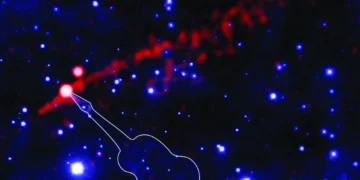Some of the most fascinating phenomena in the universe often sound like they belong in a science fiction movie rather than real-life astrophysics. The Guitar Nebula, with its “flame-throwing” structure powered by a pulsar, is one such extraordinary object. Thanks to decades of observations by NASA’s Chandra X-ray Observatory and Hubble Space Telescope, we now have a clearer picture of this cosmic spectacle.
What Is the Guitar Nebula?
The Guitar Nebula is not your average cosmic structure. Named for its uncanny resemblance to a guitar, this nebula is formed by a pulsar—a rapidly rotating neutron star—known as PSR B2224+65. The pulsar’s high-speed movement through space creates bubbles of hydrogen gas, sculpting the guitar-like shape. At the same time, a filament of energetic matter and antimatter particles, resembling a flame-thrower, stretches two light-years from the pulsar’s tip.
The nebula’s peculiar appearance comes from two simultaneous processes: the pulsar ejects particles at incredibly high energies while also interacting with denser regions of gas in its path. These interactions create the glowing hydrogen structures we see as the “guitar.”
The Role of PSR B2224+65: A Cosmic Flame-Thrower
Pulsars like PSR B2224+65 are the remnants of massive stars that exploded as supernovae. Despite their small size—often no larger than a city—they are incredibly dense, with immense magnetic fields and fast rotations. These properties make pulsars ideal engines for high-energy processes. In the case of PSR B2224+65, its rapid rotation and magnetic field create streams of particles that move along its magnetic field lines. This generates matter and antimatter pairs, including electrons and positrons, through a process that effectively reverses Einstein’s famous equation, ( E=mc^2 ).
Instead of mass converting into energy, energy converts into mass, fueling the nebula’s dramatic features. The filament of particles shooting from the pulsar is more than just a visual spectacle. It provides clues about the behavior of matter and antimatter in extreme environments and sheds light on how these particles travel through the interstellar medium.
Decades of Observations: Unveiling the Dynamics
NASA’s Chandra X-ray Observatory has been capturing X-ray images of the Guitar Nebula since 2000, with subsequent observations in 2006, 2012, and 2021. Each dataset revealed changes in the filament’s density and structure, showing how the pulsar’s interactions with its environment evolve over time. Meanwhile, the Hubble Space Telescope has been observing the pulsar’s movements and the nebula’s headstock structure since 1994, revealing subtle changes in the hydrogen bubbles over nearly three decades. These long-term observations are essential for understanding the nebula’s dynamics.
They show that the bubbles forming the guitar shape are not static but are influenced by variations in the surrounding gas density. Similarly, the X-ray filament brightens and fades over time, driven by changes in the pulsar’s environment.
What Makes the Guitar Nebula Special?
The Guitar Nebula stands out not only for its unique shape but also for its scientific value. It offers a rare opportunity to study particle acceleration, antimatter production, and the behavior of pulsar winds in detail. Particle Dynamics: The filament of matter and antimatter particles allows scientists to study how these particles move and interact with magnetic fields in interstellar space. Astrophysical Insights: The nebula provides a natural laboratory for understanding the mechanics of pulsar winds and their role in shaping cosmic structures.
Multi-Decade Data: Long-term observations from Chandra and Hubble highlight the importance of continuous monitoring in astrophysics. Without this data, the dynamic changes in the nebula would remain hidden.
The Science Behind the Guitar Nebula’s Formation
The Guitar Nebula is a product of the interplay between the pulsar’s energy and its surrounding environment. As the pulsar moves at high speed—estimated at hundreds of kilometers per second—it encounters regions of varying gas density. These density variations shape the hydrogen bubbles into the guitar-like structure we observe today. The pulsar’s wind, a stream of high-energy particles, creates the filament extending from the nebula.
This wind is confined and directed by magnetic field lines, causing the particles to spiral and emit X-rays. When the pulsar’s wind collides with denser gas, some of these particles escape, creating the flame-like structure visible in Chandra’s X-ray images.
What Can We Learn from the Guitar Nebula?
Studying the Guitar Nebula has broader implications for astrophysics: Particle Acceleration: Understanding how pulsars accelerate particles to near-light speeds can inform models of cosmic ray production and high-energy astrophysics. Interstellar Medium: The nebula’s interactions with surrounding gas reveal details about the density and structure of the interstellar medium, which plays a critical role in galaxy evolution.
Antimatter Production: The creation of positrons (antimatter particles) in the nebula provides insights into processes that may contribute to the antimatter observed in cosmic rays.
Broader Implications for Astronomy
The Guitar Nebula is not just an isolated phenomenon. Its study contributes to a broader understanding of the universe: Pulsar Wind Nebulae: Similar structures around other pulsars can be studied to identify common patterns and unique differences. High-Energy Processes: The nebula serves as a benchmark for understanding extreme energy processes in the universe.
Future Observations: The success of Chandra and Hubble in studying the Guitar Nebula underscores the importance of next-generation telescopes. Future missions could reveal even more details about pulsar-driven nebulae and their role in shaping the cosmos.
Conclusion: Why the Guitar Nebula Matters
The Guitar Nebula is a testament to the dynamic and ever-changing nature of the cosmos. Its flame-throwing filament and guitar-like shape are not just visually stunning but scientifically invaluable. By studying this extraordinary structure, astronomers gain insights into particle acceleration, antimatter production, and the behavior of the interstellar medium. As NASA’s Chandra and Hubble telescopes continue to unlock the secrets of the universe, the Guitar Nebula reminds us of the power of long-term observation and the endless surprises waiting to be discovered in the cosmos. The universe is, indeed, more creative and complex than we could ever imagine.



















